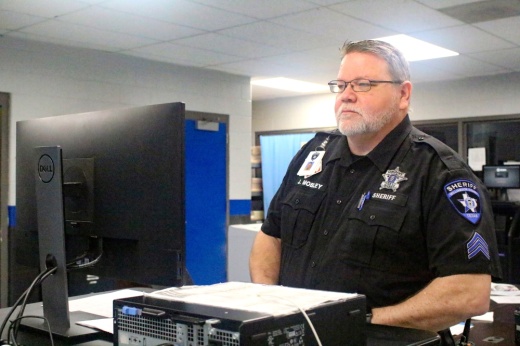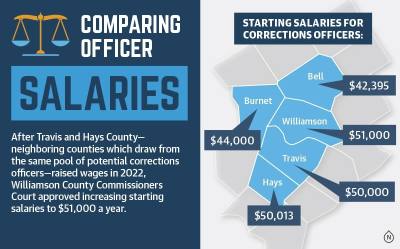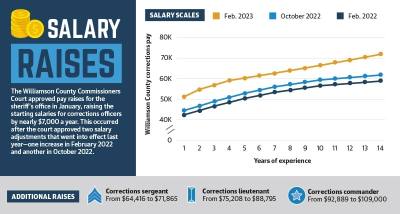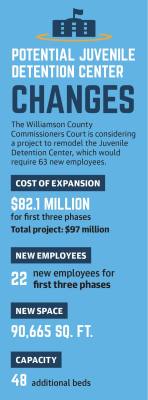Adult corrections facilities and juvenile detention centers are both facing a similar issue throughout Texas. Williamson County’s Sheriff’s Office and Juvenile Detention Center are among the pool of agencies nationwide in search of new people willing to join the profession.
As of February, the sheriff’s office had 62 corrections officer vacancies out of 256 budgeted positions. Meanwhile, the juvenile center was looking to fill 17 of its 77 positions.
These shortages have spurred Sheriff Mike Gleason and county officials to provide pay raises in an effort to improve recruitment as the county competes with area agencies to bring in new faces.
While addressing the Williamson County Commissioners Court on Jan. 24, Gleason said over the weekend leading up to the meeting, he had three corrections officers leave for other jobs in the county. Furthermore, he expected another eight of 11 hires he had going through training to be offered jobs elsewhere.
“That’s how my weekend goes every weekend right now,” he said.
The court subsequently approved raising the starting salary for corrections officers from around $44,000 to $51,000. The move will allow the county to be more competitive, Gleason said, but the solution to these staffing shortages is “a little bigger than salaries.”
State of juvenile services
Juvenile Detention Center Director David Scott Matthew said numbers started dipping when the pandemic arrived as more staff chose to retire or find other careers.
The county’s recent raises for the sheriff’s office do not apply to his department, and as the region experiences increasing growth, Matthew expects the demand for the facility he leads to only increase.
“You have to think about what kind of population we’ll have,” Matthew said. “We’re anticipating 1.2 million by 2030, which is right around the corner.”
Meanwhile, Williamson County has seen a 25% increase in violent crimes by juveniles since before the pandemic, according to Matthew.
He is also starting to see more youth come into the system. Should the state Legislature pass the Raise the Age bill, the need for juvenile services would increase as it would raise the age of criminal responsibility from 17 to 18.
Employee environment
The Williamson County Jail has 1,142 bunks and averages a population of around 600 people. Those who find employment at the facility may perform a variety of tasks, such as working in the intake area as individuals are brought in, serving as a recreation officer or becoming a medical officer.
The most common job, Sgt. Jimmy Mobley said, is working as a pod officer, which could mean guarding a 48-person pod.
“You might have a medium-maximum pod, which is a 48-man pod with one officer,” he said. “We don’t like to do that. We like to keep it as low as possible. Right now, we do have that, just due to staffing and population.”
Officers work in 12-hour shifts, and schedules rotate every other week. Together they provide inmates with clothing, food, medicine and exercise while supervising trustees—inmates who provide labor to the jail—and those who are a danger to themselves.
Mobley admitted the job can be stressful and dangerous with the potential for violence, but “it’s not what you see on TV.”
“Our convicts that come here, you really have very little issues with those guys,” he said. “It’s people who have made mistakes who come here, waiting to go to court. They just can’t afford the bail system to get out.”
The day of a juvenile supervision officer is not unlike that of a corrections officer. With a starting pay of around $42,000, these officers work with the youth at the Williamson County Juvenile Detention Center, clocking in for eight-hour shifts.
Similar to the jail, the juvenile facility never shuts down. Unlike the county correction officers, though, juvenile officers operate from what Juvenile Services Assistant Chief Matt Smith calls a “trauma-informed approach,” focusing more on working with youthful offenders so they do not become adult offenders.
However, the low starting pay and long hours mean most who apply “have to be career minded,” he said.
“Especially after the pandemic, I think people in general realized that they can make pretty good money working from home versus coming into a facility with really tough kids,” he said. “What keeps you here, once you get started, is seeing the positive change in kids and really seeing them transform into very different people that have a pretty good shot at being successful when they leave.”
Impact on staff, services
The vacancies at both departments require staff to work overtime. At the jail, officers have mandatory overtime about every 16 weeks. It is something supervisors keep a close eye on as overworked employees can throw off staff’s work-life balance, disrupt schedules and create safety concerns.
Gleason said sometimes he has to take deputies off the streets or bailiffs from the courthouse to have them work in the jail or transport inmates. Otherwise, it could lead to burnout.
The staffing problems facing Williamson County are also affecting nearby counties. In Travis County, 255 of the 726 budgeted corrections officer positions are vacant.
At the juvenile center, the shortage can pull staff away from some of the department’s core objectives, specifically engaging with youth. Matthew said it is also important to be able to separate individuals, especially in scenarios in which a teen is going through a mental health crisis. With state law requiring one officer per every eight individuals, a smaller workforce takes away from both practices.
“We want to be teaching them regulation skills and teaching them appropriate behaviors and empathy,” he said. “When you only have enough people to keep an eye on them, it makes it that much more difficult.”
The juvenile center is more than 20 years old, and it was designed to suit a ratio of one supervisor per 12 teen offenders. With this in mind, the county is in discussion to expand the facility. Commissioners Court approved the first three phases of a remodeling project costing $82.1 million on Feb. 17.
The new design would make it easier for the department to meet its ratio requirements, provide more space in preparation of increased demand and allow youth experiencing mental issues to receive individualized care. However, the first three phases would require an additional 22 employees on top of an already-depleted roster.
Precinct 3 County Commissioner Valerie Covey said while she understands the need for it, she added she is sad to see the county looking at spending significant funding for additional space to address the issue.
“There’s so much more to talk about here than just building buildings and incarcerating kids,” she said.
County, statewide efforts
Corrections officers at the jail can now start out making $51,000 a year with raises factored into their pay scale based on their years of experience. While Gleason believes it will help address staffing, he said a change in the public’s perspective of the justice system and the jobs within it is also part of the solution in facilities like this.
“A lot of people don’t really want to support our efforts at the jail,” he said. “They’re going, ‘Why do I want to invest all of this money into deputies and corrections officers when they’re taking care of somebody that we locked up because they’re a bad person?’”
Most of the inmates at the county jail, Gleason said, are not bad people, but “made a stupid mistake” that they have to work through.
While Matthew believes a starting salary of around $52,000 for supervisors would allow him to become more competitive and fill his vacancies, as he eyes state legislation that would increase funding to county juvenile programs, he is also battling a similar image issue.
“We’ve got to look at this as a revered profession,” he said. “My goal before I retire, is that the field is looked at here in Texas as a professional service like your medical industry, teachers, law enforcement and EMS.”









